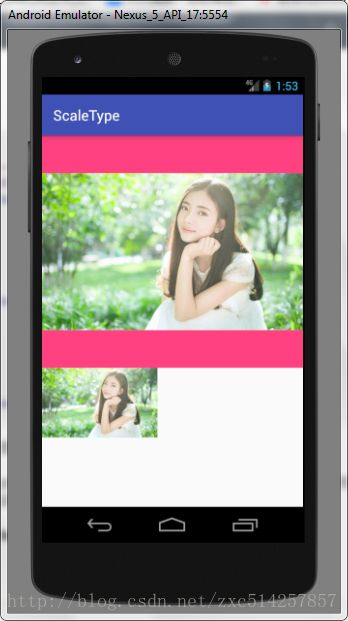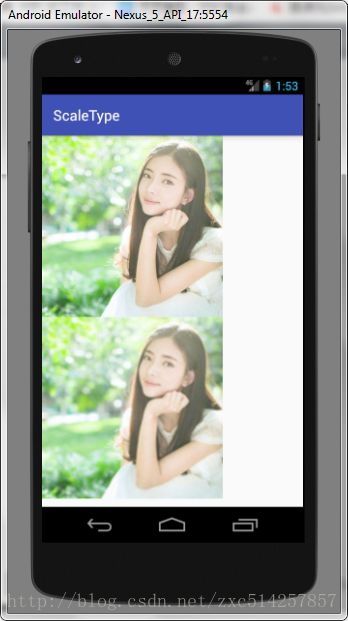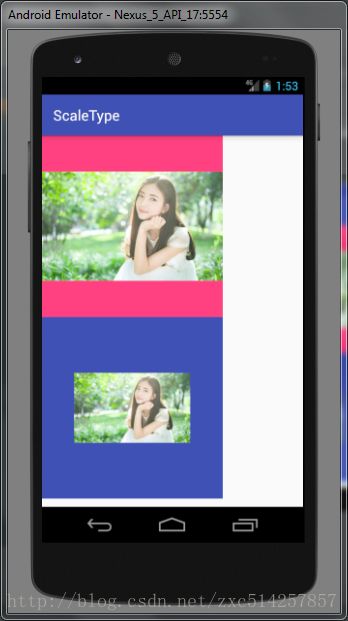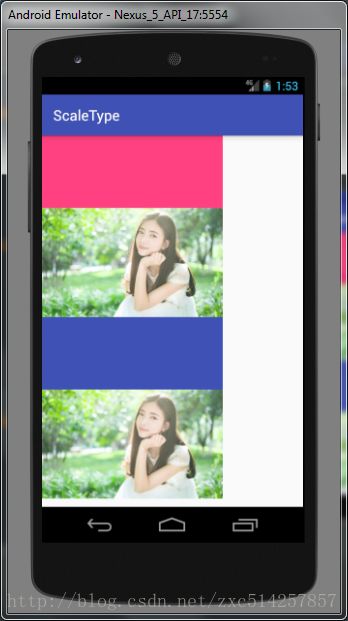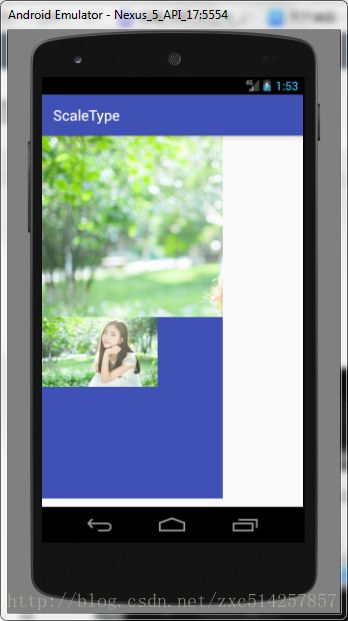Android中ImageView控件ScaleType属性使用小结
编写不易,如有转载,请声明出处: 梦回河口:http://blog.csdn.net/zxc514257857/article/details/70163346
今天工作时,需要让一个图片不按比例进行拉伸,结果想了蛮久没有想到ScaleType这个简单的属性设置,于是就写这篇进行加深巩固一下记忆。
ScaleType就是用来表示ImageView限定的宽高和图片实际的宽高之间相互妥协而产生的不同表现形式,一共八种表现形式,分别为:fitCenter,center,centerCrop,centerInside,fitEnd,fitStart,fitXY和matrix,下面就结合实例演示,详细的学习一下。
没有设置ScaleType属性前Demo代码:
<LinearLayout
xmlns:android="http://schemas.android.com/apk/res/android"
xmlns:tools="http://schemas.android.com/tools"
android:id="@+id/activity_main"
android:layout_width="match_parent"
android:layout_height="match_parent"
android:orientation="vertical"
tools:context="com.test.scaletype.MainActivity">
<ImageView
android:id="@+id/iv1"
android:src="@mipmap/pic1"
android:background="@color/colorAccent"
android:layout_width="wrap_content"
android:layout_height="wrap_content"/>
<ImageView
android:id="@+id/iv2"
android:src="@mipmap/pic2"
android:background="@color/colorPrimary"
android:layout_width="wrap_content"
android:layout_height="wrap_content"/>
LinearLayout> 这里将ImageView设置了背景色,能够更加清晰地体会ScaleType属性
可以看出,iv1图片实际的宽度大于ImageView限定的宽度,iv2图片的实际宽高和ImageView的宽高相吻合,所以没看到ImageView的背景色露出,从这张图可以让大家直观感受到iv1图片和iv2图片的大概宽高
但,只是感受宽高,我们接下来的案例代码是这样的:
<LinearLayout
xmlns:android="http://schemas.android.com/apk/res/android"
xmlns:tools="http://schemas.android.com/tools"
android:id="@+id/activity_main"
android:layout_width="match_parent"
android:layout_height="match_parent"
android:orientation="vertical"
tools:context="com.test.scaletype.MainActivity">
<ImageView
android:id="@+id/iv1"
android:src="@mipmap/pic1"
android:scaleType="fitCenter"
android:background="@color/colorAccent"
android:layout_width="250dp"
android:layout_height="250dp"/>
<ImageView
android:id="@+id/iv2"
android:src="@mipmap/pic2"
android:scaleType="fitCenter"
android:background="@color/colorPrimary"
android:layout_width="250dp"
android:layout_height="250dp"/>
LinearLayout>设置这两个ImageView控件的长宽都为250dp,最终显示效果就是这个样子,但可以明显看出,上面的图片比下面的图片清楚,但是没有设置ScaleType,为什么小的图片可以放大,大的图片可以缩小呢?
fitCenter
如果给以上两张图片各添加上
android:scaleType="fitCenter" 这个属性,会有什么样的效果?
没错!
噔噔噔噔~~~
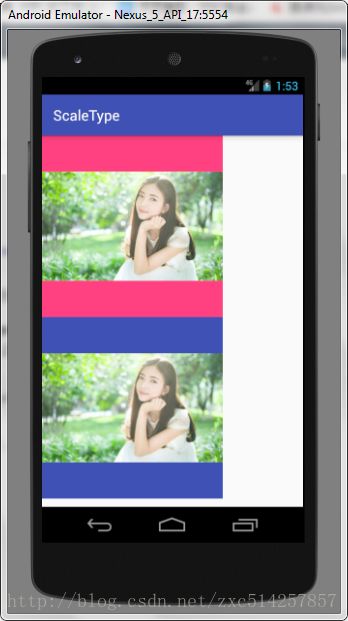
因为fitCenter是ImageView控件的默认ScaleType。
它表示把一个图片缩放到当前ImageView大小,小于ImageView的图片会放大,大于ImageView的图片会缩小。
center
添加上
android:scaleType="center"直接把图片居中显示,不进行任何缩放。如果图片有宽或高有大于ImageView的部分,就裁掉超出部分并居中显示,如果图片宽高均小于ImageView宽高,直接居中显示
centerCrop
居中显示图片,并对图片进行缩放,以大的宽或高的值去匹配ImageView控件。如果图片有宽或高有大于ImageView的部分就裁掉,适应控件并居中显示,如果图片宽高均小于ImageView宽高,适应控件并居中显示
centerInside
居中显示图片,并对图片进行缩放,以小的宽或高的值进行匹配ImageView控件。它与fitCenter的区别在于,如果是小于该控件的图,则不会放大,而是维持图的大小直接居中显示。
fitEnd
这个简单,放大或缩小图片到正好可以放入到空间中的大小,与fitCenter的不同点在于,把图片居下(长大于宽时)或居右(宽大于长时)显示。
fitStart
都会抢答啦!
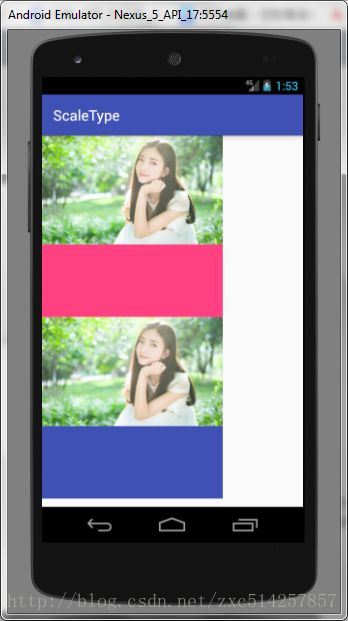
与fitEnd基本相同,只是图片会居左或居上显示。
fitXY
这个是比较特殊的一个,用得也相对较多,唯一不等比例的一个
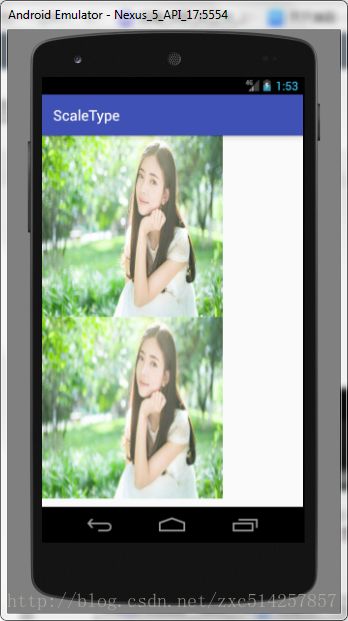
不固定长宽比例地缩小或放大图片,直到用图片把控件区域全部填满。
matrix
与center相似,都是不缩放图片进行显示。不同点在于,用矩阵的方式绘制,从控件的左上角开始,而不是像center一样,从中间开始显示。
算啦,总结完感觉记不住多少,只是理解了一些,以后需要的时候再翻博客吧!
———-因本人才疏学浅,如博客或Demo中有错误的地方请大家随意指出,与大家一起讨论,共同进步,谢谢!———-
